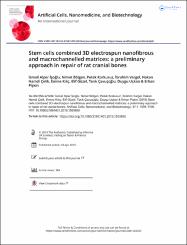Stem cells combined 3D electrospun nanofibrous and macrochannelled matrices: a preliminary approach in repair of rat cranial bones

Göster/
Erişim
info:eu-repo/semantics/openAccessTarih
2019Yazar
İşoğlu, İsmail AlperBölgen, Nimet
Korkusuz, Petek
Vargel, İbrahim
Çelik, Hakan Hamdi
Kılıç, Emine
Güzel, Elif
Çavuşoğlu, Tarık
Uçkan, Duygu
Pişkin, Erhan
Üst veri
Tüm öğe kaydını gösterÖzet
Repair of cranial bone defects is an important problem in the clinical area. The use of scaffolds combined with stem cells has become a focus in the reconstruction of critical-sized bone defects. Electrospinning became a very attracting method in the preparation of tissue engineering scaffolds in the last decade, due to the unique nanofibrous structure of the electrospun matrices. However, they have a limitation for three dimensional (3D) applications, due to their two-dimensional structure and pore size which is smaller than a cellular diameter which cannot allow cell migration within the structure. In this study, electrospun poly(e-caprolactone) (PCL) membranes were spirally wounded to prepare 3D matrices composed of nanofibers and macrochannels. Mesenchymal stromal/stem cells were injected inside the scaffolds after the constructs were implanted in the cranial bone defects in rats. New bone formation, vascularisation and intramembranous ossification of the critical size calvarial defect were accelerated by using mesenchymal stem cells combined 3D spiral-wounded electrospun matrices.

















